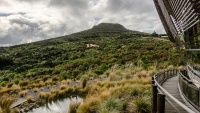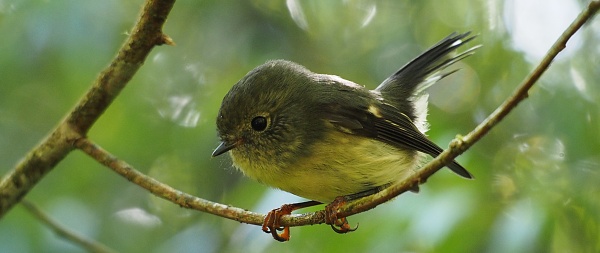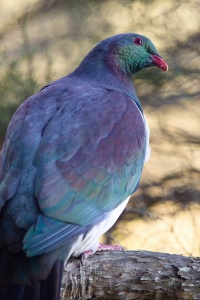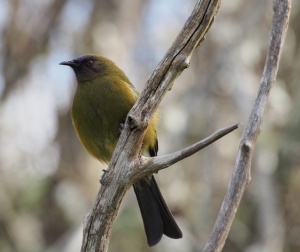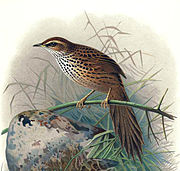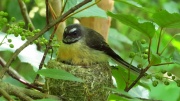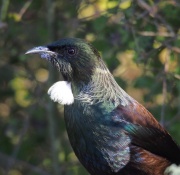Orokonui Ecosanctuary/Nga Manu - Birds
From WikiEducator
Contents
Nga Manu-Birds
(class Aves or clade Avialae)
- Feathers, beak - no teeth, lay hard-shelled eggs, high metabolic rate (the amount of energy used up when resting), four-chambered heart (like humans) and a lightweight strong skeleton. All modern birds have wings; moa, had no wings!
Bird Characteristics
- Smart - parrots - kaka, kea, kakapo and kakariki as well as corvids (NZ raven extinct - oops) are among the most intelligent animal species.
- Several bird species make and use tools, and many are social and share knowledge across generations - NZ examples...
- Many species migrate, some perform shorter acrobatic type movements in the same area
- Birds are social, communicating with visual signals, calls, and songs, and participating in such social behaviours as cooperative hunting, flocking, and mobbing of predators.
- The majority of bird species are monogamous (married), usually for one breeding season, sometimes for many years, but rarely for life.
- Courtship displays (male only??) enable the female to compare her prospective mates colours and skills of singing, jumping, flying etc
- Colourisation - depth of colour can indicate
- Age (NZ e.g??) older birds indicate ability to be resourceful
- Food type - carotenoid orange under wings of kaka ?
- Life span - varies from
- short 3 years of pīwakawaka the fantail to
- 60 year old Grandma, a Northern royal albatross who bred at Taiaroa head
- short 3 years of pīwakawaka the fantail to
- Eggs are usually laid in a nest and incubated by the parents
- Most chicks have a period of parental care after hatching
- Coaxed or pushed from the nest or burrow...flap, waddle, feed
- Birds can be found in folklore, religion, and cultures
- Breeding - often monogamous
- Short term - same mate for raising chicks but not necessarily be the father
- Long term - same mate, multiple mates
- Faeces - indicates what food they eat
- White paste - urate (made of uric-acid crystals) is a by-product of bird kidneys
- Dark solid waste - stool - colour from the bird's diet
- Black blob on a squirt of liquid white - kiwi
- Green, cylindrical plant matter with white ends - takahe
- Brownish and seedy - kereru
- Containing fur, bones - ruru?
- Indicator of bird health - abnormal colours:
- Red urate may be signs of internal bleeding
- Brown urate may signal lead poisoning
- Green/yellow urate may mean liver disease
- Indicator of bird health - abnormal colours:
Aotearoa Perspective
- Evolution
- Gondwana breaks away
- Kiwi rattite - elephant bird
- Moa - south american rail?
- Plants
- Divarication
- Leaf changing of horoeka plant above the height of tallest Moa - horoeka in Chatham Islands does't display same change, Chathams never had moa.
- Endangered species
- Panda approximately 3000 remaining in the wild
Birds of Orokonui
Kākā
- Endemic to New Zealand and one of only 3 parrot species of Nestoridae, the others are the Kea and Kakapo
- Nestoridae - an ancient family of large parrots which evolved from true parrots before New Zealand broke away from Gondwana
- This family differs from the 4 other species of endemic parrot we have in New Zealand (the kakariki) which are descended from the true parrot family
- Nestoridae - an ancient family of large parrots which evolved from true parrots before New Zealand broke away from Gondwana
- Formerly widespread and quite common on all 3 main islands
- Number of kaka has severely reduced since European colonisation
- Initially from deforestation now from introduced predators and competitors
- Number of kaka has severely reduced since European colonisation
- Clever birds who chatter to each other in loud harsh calls
- Laughing, whistling and "clohck"ing!
- Flocks of kākā led by a female
- She rounds up strays and herds flock to the next food source
- Whakatauki
He kaka kai uta, he manga te moana What the barracouta is at sea so is the Kaka on land, one wrecks the net of the fisherman, the other wrecks the wood and snares of the hunter
Kaka News
- Botanic garden kaka returns to her birthplace, visiting parents or looking for a mate?
- A kaka's skull, feathers and transmitter were found 2km outside the sanctuary. The kaka was probably killed by a...?
Kereru - NZ Pigeon
- Kererū - aka:kukupa,kuku - resemblance to sound made when cooing, kuu, kuu
- Its roll as seed disperser especially important since moa extinction - tawa and other big berries can only be eaten by kereru - weep, weep of the tawa mamas who need their drupe babies to be spread far and wide
- Large mouth - pineapple eater if human size
- Frugivorous, primarily eating fruits and drupes. Also browses on leaves and buds, especially nitrogen rich foliage during breeding season e.g Kōwhai, broom
- In what way does eating nitrogen rich food assist the kereru?
- Plumage owes colour to Maui the trickster who tried to follow his mother by first hiding her beautiful coloured skirt, then as she plunged into dark hole Maui followed her in the form of a kereru wearing the skirt
- Munch discard, munch discard - gulp, slide across tongue, squeeze down oesophagus and plop into the crop - the temporary food storage pouch. Then into the proventriculus another storage area that uses enzymes to break down the food. Squeezed into the gizzard, a specialized stomach constructed of thick muscular walls, which grinds up food using small pebbles. Then intestines, sausage like and to the cloaca; which is the posterior opening for seed covering of blankets - a mix of poos and wees!
- Fast, undulating flights - wing strokes pause, swooping, half looping, noisy.
- Foliage crash landing, bumble, tumble grab and peer about.
- Nest - dishevelled twigs, high, just below canopy - unlucky to ever see a kereru nest
- Pigeon milk - rhythmical pumping of regurgitation gloopity gloop, from both parents into a chick that has waited patiently for this delivery
Kiwi - Haast tokoeka
- Kiwi waiata
- Orokonui has 35+ kiwi with reports of small kiwi prints in different parts of the sanctuary
- Approximately 350 left in the wild
- Brown stumpy, no tails, straggly-hair-like feathers, a long pliable bill, with whiskers at the base and nostrils at end - no wonder a lot of kiwi teens go emu!
- Feeds on bugs, worms, larvae, eels, amphibians as well as berries and fruit
- Vanilla mint ice-cream, a double smidgeon of chocolate sauce - poo!
- Musky smell of Kiwi make it easy for mammal predators to track them to their burrow
- Fire pond fenced after kiwi drowns - long pointed toes and wing stumps are no aids for swimming
- Can smell up to 30cm below surface of ground???
- Father incubates
- No egg tooth on un-hatched chick beak - legs push and claw
Kiwi News Kiwi in Dunedin after 130 years
Korimako - Bellbird
- Males - olive green
- Females - browner
- Monogamous - pairs remain together, maintain same breeding territory, for several years
- Egg laying September to January often raising two broods
- Nest built mainly by the female and usually near a flowering tree
- Loose construction of twigs and fibre and lined with moss, fine grass, feathers or wool
- Three to four eggs laid at daily intervals - incubated by the female
- She may be fed by the male but regularly leaves the nest to feed
- Incubation and fledging both take about 14 days
- She may be fed by the male but regularly leaves the nest to feed
- Chicks fed mostly by the female
- The female defends her nest and young, physically attacking intruders
- She will also fall to the ground and flap away through the undergrowth to distract a predator
Hutia te rito o te harakeke, kei whea te kōmako e kō? Kī mai ki ahau, he aha te mea nui o te Ao? Māku e kī atu, he tāngata, he tāngata, he tāngata
If the heart of harakeke was removed, where will the bellbird sing? If I was asked, what was the most important thing in the world; I would reply, it is people, it is people, it is people!
- This whakatauki (proverb) relects the Maori reference to the harakeke plant as a whanau or family group
- The outer leaves - tupuna (ancestors); the inner leaves - mātua (parents); the most inner leaf - rito or pepe (baby)
- Only the tupuna are cut as the mātua are left to protect the pepe
- Without the sound of children in the world (the next generation) mankind will not survive.
- Only the tupuna are cut as the mātua are left to protect the pepe
- The outer leaves - tupuna (ancestors); the inner leaves - mātua (parents); the most inner leaf - rito or pepe (baby)
Mātātā - Fernbird
- Insectivorous
- Early settlers called it the "swamp sparrow"
- Almost half its length is tail
- Ground-dwelling bird, reluctant flier, travelling mainly on foot or occasional short flights
- Pūreke - rain cape made from harakeke/flax - te whare o te mātātā - a mātātā house
- Mātātā nests are snug and well sheltered - often in flax
- Māori revered the fernbird as an "oracle" or "Wise bird" (Manu tohu)
Moa (extinct)
- Females bigger than males
- Males most probably incubated the egg
- Many NZ plants evolved defensive features to stop the moa from browsing on them
- Divaricate - small-leaved shrubs and low-growing trees with densely interlaced stems
- Stems spread apart at wide angles and leaves are often small with few available for potential browsers
- Avoids browsing by moa
- Stems spread apart at wide angles and leaves are often small with few available for potential browsers
- Links - Moa
Pīwakawaka - Fantail
Takahē
- 263 Known takahē - 2013
- Deemed extinct twice - rediscovered by Geoffrey Orbell near Lake Te Anau in the Murchison Mountains, 1948
- Orokonui have one pair of takahē called Quammen and Paku.
- Paku the female laid one egg in 2013 - didn't hatch, built another nest and laid another egg
- Infertility of takahē due to inbreeding depression
- Paku the female laid one egg in 2013 - didn't hatch, built another nest and laid another egg
- Takahē pair for life - up to 12 years
- Eats grass, shoots and insects, but predominantly tussock and other alpine grass species
- Have been seen eating a putangitangi duckling
- Poo is cylindrical, green and white ended
- Up to 7 metres of finger size pellets per day
Takahē News A bird brought back from the dead
Tītipounamu - Rifleman
- Rifleman, New Zealand's smallest bird
Tui
- Two voice boxes
- Hopping stance - kapahaka
Activities
Poo detective agency
- Identify poos
- Poo cycle
- Where does our poo go?
- Poo bomb
- Digestive system
